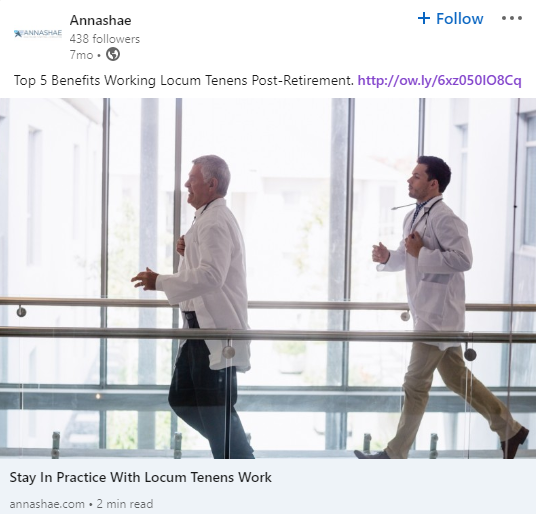In This Issue:
- Medical Support Staff Is Neglected, Disrespected and Mistreated
- 14 Great Podcasts and Blogs for Locum Tenens Doctors
- Why Should You Work with a Locum Tenens Staffing Agency?
- When Should I Share my CV with a Recruiter?
- Eliminating Physician Burnout Before It Starts
- 7 Ways to Find More Work-Life Balance as a Physician
- Financial Modeling May Simplify Compensation Arrangements, Help Physicians Gauge Job Risk
- Socially Speaking: Posts from Annashae, LocumStory, and Weatherby
- How Locum Tenens Works & Why to Try It
Medical Support Staff Is Neglected, Disrespected and Mistreated
(Edited from KevinMD article by Leah Wilson, NP, and Diana Lemly, MD, 11/21/2022)
Medical support staff is leaving in droves, leaving patients’ health at greater risk.
Calls and messages to doctors’ offices have surged as patients try to access care. Wait times skyrocket to book visits. News stories about the current state of the healthcare system typically focus on the plight of doctors and nurses. Studies detail the “Great Resignation” impairing the healthcare industry:
A new report published last month estimates that since 2020, one in five healthcare workers (including physicians, NPs/PAs, physical therapists, and social workers) have quit their jobs since the pandemic began, and 47% altogether plan to leave their positions by 2025.
According to the US Bureau of Labor Statistics, 500,000 nurses will leave the workforce in 2022, bringing the overall deficit to 1.1 million nurses. These staffing shortages are hurting patients — e.g., contributing to the current pediatric bed shortage in the midst of a surge in respiratory infections.
Crucial, But Overlooked
However, these reports (and the alarming headlines) fail to include another critical labor force in healthcare: medical support staff. Medical support staff includes many positions: reception, nursing aids, medical assistants, and referral support. Protecting them is critical to prevent the further crumbling of our healthcare system.
But we don’t even know how many of these crucial staff members keep the system running. Our research indicates there are more than 6.6 million medical support workers in the US. This total includes veterinary medicine and dental hygiene positions but doesn’t include medical receptionists/front desk staff, who answer phone calls.
Such imprecise data about this population contributes to their invisibility.
Anecdotally we know that many medical support staff, including front desk staff; medical assistants, and nurses’ aides, are quitting. Headlines talk about doctors and nurses leaving, but the support staff exodus is probably more extreme. The only published study of its kind found a turnover rate for medical assistants of 59% in one year in one large primary care practice.
Why the Turnover?
A 2022 MGMA Stat poll asked medical practices what staff role was most difficult to recruit: the majority of respondents (44 percent) said medical assistants (MAs), followed by nurses (27 percent), administrative/billing staff (18 percent), and other clinical staff (10 percent).
In the primary care clinic where we work, 11 support staff out of 30 -– more than a third -– have left their positions in the past two years. Their reasons for leaving include low wages and lack of perceived respect.
The official living wage in Massachusetts for an individual with no children is $21 per hour, yet the average medical assistant salary in Massachusetts is only $16 per hour. Given the high cost of living near many city-based medical centers, the support staff has to live far from their jobs without the option of working remotely.
And it’s not just low wages and lengthy commutes.
Medical support staff on the job endure constant demands from angry patients (via phone, email, and patient portals) and burned-out medical providers. Support staff is the flashpoint between patients and clinicians. They bear the brunt of patient frustration with the system and, remarkably, are more likely to experience workplace violence than employees in all other industries.
So when other industries beckon — the restaurant industry has recently increased wages to over $15 per hour for non-supervisory staff, and companies like Amazon, Starbucks, and Target are all offering a starting wage of $15 per hour or higher — it’s not a difficult decision to leave.
The frequent turnover in these roles contributes to the invisibility and low wages. If employees stayed in their positions, both would likely improve.
The “Snowball Effect”
All industries are having trouble retaining workers, with expenses and inflation increasing (particularly in healthcare). Hospital systems may believe they can’t afford increased wages or improving work environments for medical support staff, but the gaps in staffing and continued high rates of turnover only increase costs further.
Medicine needs a team approach to provide good care and reduce burnout. If discontented or temporary support staff are unreliable team members, the whole environment becomes less stable, and resignations snowball, including those of doctors and nurses. Patients will get fragmented, rushed, and substandard care. Dedicated, consistent medical support staff save lives, building important relationships with patients; navigating insurance requirements; scheduling critical imaging tests and appointments; and collecting key clinical information.
Our failure even to quantify medical support staff speaks to how this group of employees is neglected, disrespected, and mistreated. We need to recognize, count and support these key healthcare team members before it is too late.
Leah Wilson is a nurse practitioner. Diana Lemly is an internal medicine-pediatrics physician.
All News Is Locums
14 Great Podcasts and Blogs for Locum Tenens Doctors
(Edited from Global Medical Staffing blog post, 10/11/2022)
Podcasts are easy to listen to almost anywhere — while commuting, while exercising, or even while doing household chores. The best podcasts are funny, inspiring, and knowledge-filled.
With so many podcasts available, as well as so many great blogs, it can be hard to find the most beneficial and enjoyable ones, so we sorted through them for you.
Here are some of the best podcasts and blogs specifically for doctors and locum physicians.
1. Reach MD
This podcast, available on the website or through mobile apps for iPhone and Android, is a great way to keep up with clinical research and practice techniques. It offers several themed series, including one dedicated to locum tenens with episodes like this one from an international locums insider covering some of his clinical research conducted while on assignment in New Zealand.
“Reach MD” includes numerous other ongoing series, including “Grand Rounds Nation” with outstanding talks from top academic centers. Another series is “Primary Care Today,” with clinical experts highlighting the latest trends in primary care practice.
2. Kevin MD
Founded in 2004 by Kevin Pho, MD, KevinMD.com is a great way to keep up with the pulse of the industry as told in blogs by thousands of physicians, advanced practitioners, nurses, medical students, policy experts, and patients. It covers numerous aspects of the healthcare industry — including policy, meds, tech, and private practice — and is easy to browse on a smartphone.
3. TED Health
Part of the well-known TED Talk series, TED Health covers a wide array of topics in typical “TED Talks” fashion. This podcast will help answer your questions and share ideas that they say you won’t hear anywhere else, all centered around how to live and lead healthier lives.
4. Physician’s Weekly
Listen to Physician’s Weekly here
Written exclusively for healthcare professionals, this blog covers a broad range of industry topics like landmark research, current topics in healthcare, and specialty-specific content. Physician’s Weekly also offers a weekly podcast and “Doctor’s Voice”, a blog written by and specifically for physicians.
5. The White Coat Investor
Listen to The White Coat Investor here
“The White Coat Investor” delivers information to help physicians better manage their finances, from how to pay off student loans to how to invest strategically. You can listen to the podcasts on iTunes, Overcast, Acast, Stitcher, or Google Play. The blog itself provides tons of information about better money management from doctors for doctors.
6. Physician Side Gigs
Listen to Physician Side Gigs here
This blog site explores ways for physicians to make extra income, gain the tax benefits that non-W2 endeavors provide, and help physicians think about ways to make passive income instead of always trading time for dollars. Read blog posts and join the Facebook group to hear how other physicians are making extra income.
7. Passive Income MD
Listen to Passive Income MD here
Practicing anesthesiologist Dr. Peter Kim created “Passive Income MD” to serve as a personal documentation of his journey to find ways to achieve passive income, with the goal of spending more time with loved ones. Get how-tos and ideas, learned from his and others’ failed experiments, and hear from other fellow doctors.
8. Physician Philosopher
Listen to Physician Philosopher here
The “Physician Philosopher” blog by an anesthesiologist in academia seeks to help doctors attain financial independence by focusing on doing the 20% right with money and wealth in order to get 80% worth of results. The goal: to obtain a life well-lived.
In addition to how-tos, it includes numerous blog interviews with physicians posted on the site (that you can listen to through your smartphone) who have made smart decisions to build wealth.
9. Physician on FIRE
Listen to Physician on FIRE here
FIRE stands for: “financial independence, retire early.” A doctor who built enough wealth by age 39 to retire (but who remains in the medical field out of passion) runs the site. The entire website with all of its blog content, calculators, and other resources all revolve around helping physicians attain financial independence, whether the goal is to retire early to pursue other passions, cut back on work, or build wealth and use money more strategically.
10. Locumstory.com
Locumstory.com is for physicians, PAs, and NPs interested in, or already involved in, locum tenens and provides numerous stories and resources for physicians still deciding whether locums fits their careers and lives. Get valuable information from blog stories, videos, physician stories, quizzes, PDF downloads, and other resources about everything from what you need to know about taxes as a locum tenens doctor, to what it’s like to practice in various places around the world or in the US.
11. The Happy Doctor
Listen to The Happy Doctor here
This podcast shares ways physicians and medical students are finding happiness, purpose, and inspiration for providing healthcare. The stories, tips, and knowledge reconnect students and physicians to a love of medicine in a simple, personalized, and practical way — and they’re easy to listen to while commuting, exercising, or taking a break. Listen through the website, iTunes, or Stitcher.
12. Physician Grind
Listen to the Physician Grind here
On the “Physician Grind” podcast, doctors and other healthcare providers discuss ‘the beautiful, the bad, and the ugly in medicine’ through true, remarkable stories. Each episode focuses on one in-depth story and lasts about five minutes. Listen through the website. The stories are truly entertaining.
13. ZDoggMD
UCSF/Stanford-trained internist Dr. Zubin Damania began publishing videos and live shows as ZDoggMD to address the burnout he was experiencing. ZDogg’s hilarious YouTube parody videos have millions of views, but in his podcast he has conversations with healthcare professionals about topics on things such as COVID personality changes, Omicron-specific boosters, and the future of humanity.
14. Amateur Traveler
Listen to Amateur Traveler here
Whether you’re a veteran locum physician or headed on your first assignment, this award-winning podcast is full of tips and suggestions on where to visit and what to check out while you’re there. Hosted by world traveler Chris Christensen, “Amateur Traveler” will teach you how to best explore every location where you’re on assignment. Christensen shares tales of his travels, and this podcast will whet your appetite as an explorer!
Happy reading and listening!
Why Should You Work with a Locum Tenens Staffing Agency?
(Edited from Health Carousel blog post, 11/11/2022)
With the shortage of skilled healthcare workers across the country (gaps could be as large as 37,800 to 124,000 healthcare professionals by 2034), recruitment continues to be a challenge for healthcare organizations.
To address this issue, many hospitals and healthcare facilities have turned to hiring locum tenens physicians as a solution. “Locum tenens” physicians or advanced practitioners are ‘temporary physicians’ that can fill in coverage gaps due to vacations, holidays, illness, expansions, or general staff shortages.
Sourcing healthcare professionals can strain hospital administration since it costs time and money to search for appropriate candidates to hire. As a result, many healthcare organizations have started working with locum tenens staffing agencies.
Benefits of Working with a Locums Staffing Agency
1. Access to a Large Pool of Candidates
Staffing agencies often have access to large numbers of pre-qualified physicians with proven track records across a variety of specialties.
Since many assignments are short-term, it’s easy to identify behavior and physician performance patterns: Agency recruiters will tell you if the potential candidate is a team player, has a problematic personality, documents and signs their notes on time, or is savvy with a specific technology.
Recruiters are dedicated to building relationships with both the doctors and provider networks so that they can find the best fit for open job postings.
2. You Can “Try Before You Buy”
It is estimated that the cost of recruiting a physician can reach three to four times the physician’s annual salary. This cost includes actual recruitment costs, lost revenue during the recruitment period, and staff hours during the hiring process.
It takes a long time to end a relationship with a new physician who isn’t a good fit. The benefit of working with a locum tenens agency is that you can “try before you buy,” so it’s easy to terminate the relationship with minimal time or cost.
3. High Retention Rates
Physician burnout is common in the medical community. This results in increased turnover, disrupts work processes, lowers morale, causes gaps in patient care, and potentially affects an organization’s reputation.
Working with a locum tenens agency offers hospitals a flexible staffing solution they can use to combat physician burnout. Retention and performance rates generally improve when full-time healthcare staff are allowed to take time off.
Likewise, locum tenens providers are more likely to accept a permanent position if they have previous experience at a specific location.
4. Time-Saving Services and Support
Locum tenens agencies save hospital administrators time by taking care of all the details required to get a locum tenens provider in the door. Agencies typically handle the credentialing process, contract negotiations, and insurance and living arrangements for the candidate.
5. How We Can Help
Agencies offer quality, speed, and flexibility for healthcare organizations needing locum tenens solutions. Most provide contracts to fit your needs, ranging from locum tenens to direct-hire to contract-to-hire for physicians and advanced practice providers.
Using their deep well of prospects for healthcare facilities, agency recruiters will search for the best possible fit for your job postings.
Agencies like Health Carousel Locum Tenens will take care of the entire credentialing process for you, allowing providers to get started right away.
When Should I Share my CV with a Recruiter?
(Edited from Concorde Staff Source blog post)
It is imperative that you protect your curriculum vitae (CV) and your confidentiality in a job search: If you send your CV to a recruiter, they should never release it without your permission.
So, what standards do ethical recruiters follow?
Any ethical recruiter should tell you:
- Name of the hospital, clinic, or group
- Location of the opportunity *
- With whom the CV will be shared
- Details about the opportunity/assignment
This is the minimum industry standard. (* If you get a vague answer like, “northern Michigan,” do not grant your permission to share the CV.)
For more hints like this, contact Concord(e) Staff Source, a founding member of both the National Association of Physician Recruiters (NAPR) and the National Association of Locum Tenens Organizations (NALTO), now celebrating its 50th Year in business.
The Healthcare Staffing Story
Eliminating Physician Burnout Before It Starts
(Lightly edited from Psychology Today article by Josh Webb, MD, 11/15/2022)
Let’s equip medical students for the frontlines of care.
Key Points:
- How can the healthcare industry relieve workers’ extreme mental strain that leads to burnout?
- People who have dedicated years of their lives to caring for others often lose sight of how to care for themselves.
- Let’s proactively address burnout before it begins.
Even before the pandemic, healthcare worker burnout was too common. In a 2019 study from the National Academy of Medicine, up to 54% of nurses and physicians and up to 60% of medical students reported experiencing burnout.
Post-pandemic, however, it became pervasive and intolerable, inciting negative feelings about work. In a 2021 survey, at least a third of frontline healthcare workers who assisted with patient care and administrative tasks said they’d considered leaving healthcare, and another 2021 survey found that 67% of nurses plan to leave their positions within three years.
How can the healthcare industry relieve extreme mental strain on workers leading to burnout? How can we help those who help so many others on any given day?
Many will jump to answer with immediate solutions such as mental health access, funding, and so on. All are needed and appropriate, but we have to be more proactive, which means starting at the beginning – starting with medical students.
Our medical school, for one, is bringing this vision to life through multiple efforts. They include developing a “flipped classroom model” that readily makes available resources the student body can access.
Flipping the Classroom Model
Providing students with a solid foundation of academic knowledge, clinical skills, and patient-centered care is needed. A flipped classroom model allows students to spend their time outside the classroom reviewing reading materials and lectures, and their time inside the classroom conducting active learning.
This is a deviation from the traditional (and sometimes uninspiring) 100-slide PowerPoint presentations. Dynamic, case-based discussions integrating all aspects of medicine are the future. These methods help students see or develop novel solutions to problems, which is extremely useful as they advance to their careers.
What’s more, these methods allow students to immerse themselves in a real-world setting, learning skills that will allow them to navigate challenging situations earlier in their careers – which can equip them to better handle more stressful scenarios later.
Mapping Out the Mental-Wellness Journey
A variety of support systems should be in place for students to address burnout proactively before it begins to affect their studies.
Programs can match students with ‘academic success partners’ upon arrival to provide guidance throughout their medical school journey. This is a way to help students manage their work-life balance before burnout begins, and seek help should the need arise.
Creating White Space for White Coats
Putting on a medical white coat represents many things, including the time and dedication – mentally and physically – that went into securing it. Most healthcare workers want to show up and be the best they can be. Often, it’s literally a matter of life or death.
It’s important for them to let themselves off the hook a bit and take some personal time to recharge. People who have dedicated years to caring for others often lose sight of how to care for themselves. And they deserve all the help they can get.
With allocated white spaces, students are given back the time needed to maintain wellness and foster lifelong learning through independent study, self-learning, and “time to breathe.” This also fosters the idea early on that this “me time” is not just nice to have, but critical, so students can show up as their “best selves.”
Individuals who go into medicine face a lot of external demands, not to mention the ones they put on themselves. Today the need to address the contributing factors of clinician burnout is even more urgent because of a growing demand for healthcare services.
The US Bureau of Labor Statistics predicts this demand will increase over the coming decade because of our aging population and an increasing number of patients with chronic conditions.
7 Ways to Find More Work-Life Balance as a Physician
(Lightly edited from Medical Economics article by Lauren Hanson, 11/15/2022)
In this day and age, overworking has become the norm, but that doesn’t mean it should be.
When we work too hard for too long, the resulting stress and exhaustion wreak havoc on us physically and mentally. That’s why finding a healthy work-life balance is so crucial – yet more than 66% of Americans say they don’t have one.
This is especially true for physicians, who are far more likely than the general population to experience burnout.
Recent research from the American Medical Association shows that more than half of physicians are experiencing burnout. The most common factors include things like physician-patient relationships, regulations, professional liability, and heavy work hours (an average of over 51 hours per week). This lack of work-life balance is destructive to both physicians and their patients.
For physicians looking to combat feelings of burnout and establish true work-life balance, here are seven areas of focus to consider.
1. Set Boundaries
Many physicians find it difficult to set boundaries, but doing so is an excellent form of self-care. When done correctly, setting boundaries can improve your life, both personally and professionally.
Boundaries are meant to protect our basic needs (physical, emotional, mental, and time) so that we can be our best selves and remain productive and energetic.
There are three types of boundaries to consider setting to help separate your personal and professional lives:
- Temporal boundaries. These are specifically for leisure activities, such as spending time with loved ones or taking part in your favorite forms of exercise. Try to set aside a specific time each day or week to dedicate to these activities.
- Physical boundaries. Physical boundaries create a literal distance between your work life and your home life. The idea of turning off your phone or computer may seem laughable, but even doing so long enough to enjoy a meal is still a successful boundary.
- Cognitive boundaries. A cognitive boundary is one that allows you to leave work behind completely (and not turn your phone or computer back on). Like setting a physical boundary, this is impossible for some, but dedicating time each week to just yourself is enough.
Don’t forget that the word “no” is a boundary within itself. Saying “yes” and taking on more when your plate is already full leads to more burnout. In turn, more burnout leads to resentment and takes a toll on the psyche. Sometimes, “no” is the best boundary you can set.
2. Remember that working all day and then binging Netflix isn’t work-life balance.
It’s common today to unwind after a hard shift by turning off your mind and turning on the TV. In a recent study, 80% said they choose to relax by doing so. However, binge-watching is actually more likely to increase stress, anxiety, and depression; it can also have negative effects on sleep.
Instead, try picking up a new book, getting outside, exercising, or socializing with family and friends. Even spending time with your pets can help improve cortisol levels, heart rate, and mental health.
3. Make And Defend A Life Schedule
Go old school and use paper and colored pens to create, stick to, and defend what Dr. Dike Drummond calls “a life calendar.” Once a week, meet with your entire household and have everyone write down what they have going on in pens of different colors. Next, write what you want to do outside of medicine that week. It could include getting coffee with a friend or family member, going out with your spouse, or exercising – anything but medicine. Whatever it is, put it on the calendar.
The easy part is done; now it’s up to you to defend it.
If someone asks you to do something, such as taking on an extra shift or staying for an extra hour, you must check your life calendar before deciding. If you see there’s a commitment, stick to it and say “no.”
When you use a life calendar, you’ll see your happiness improve and have a better sense of fulfillment. But before creating one, be sure to have a clear idea of your values and the things that are important to you.
4. Outsource Your Life When Possible
Outsourcing your life doesn’t mean handing off everything on your to-do list. Instead, it simply means taking the most mundane tasks and hiring someone else to do them at a low cost.
You can outsource almost anything, including cleaning, dog-walking, calendar scheduling, and laundry. You could even have someone mount your television through an app like TaskRabbit.
Why pay people to do things you could do for free? Because you’re buying back the rarest of commodities: time. Skipping mundane or unenjoyable tasks leaves you with more time to do what you enjoy.
One Harvard professor found that getting your time back improves quality of life and that those who prioritize time over money are happier in the long run. She even came up with a metric to measure it (called “happiness dollars”) and found that outsourcing chores can make you as happy as receiving an $18,000 raise.
5. Find the Right Employer
Sometimes, your work-life balance comes down to work environment. If you’re experiencing burnout, it might be time to consider a new workplace.
When interviewing, decide what you want and need for work-life balance. What’s important to you? How do you want your schedule to look? What do you need time for each week?
It’s also important to ask questions of a potential employer to better understand the workplace culture and decide if you want to spend your time and energy there: What are workdays like? Why is the position open? What will they expect you to accomplish in the near future?
Better yet, take a look at the other employees. If they’re happy and friendly, there’s probably some semblance of work-life balance.
You might consider changing how you work. Many medical group practices shifted their workers to hybrid work in 2021 and saw improved performance, productivity, and engagement. Likewise, physicians who have pivoted to a telehealth career noted increased job satisfaction and timeliness of patient care.
6. Spend 20% of your work hours doing something you’re passionate about.
Research has found that doctors who spend less than one-fifth of their full-time equivalent (FTE) on things they’re passionate about are far more likely to suffer burnout than others.
Spending the equivalent of one half-day per week doing something you care about will not only help you stay engaged at work but also remind you why you wanted to become a doctor. What you focus on is up to you: It could be researching, working with patients, or managing your team. There are no limits.
You might even pursue a side gig or project to create the feeling of work-life balance. While it doesn’t have to be related to medicine, there are several routes you could take, including life or career coaching, medical writing, MCAT tutoring, or consulting.
7. Take Your Vacation
Finally, take your vacation! You earned your days off, so why not use them?
Research shows that one-third of physicians take two weeks or less of vacation each year, but taking that time away is crucial. Not only does it help to reduce work-related stress, but it also helps regulate your emotional and physical states, increases time with loved ones, and improves work performance.
Physicians are constantly telling their patients to ‘go easy, and relax,’ so why aren’t they following their own advice? It’s not easy to achieve work-life balance, and doing so will take time and dedication. Remember, it won’t solve all of your problems – but it’s a great place to start.
Tools to Try/News to Use
Financial Modeling May Simplify Compensation Arrangements, Help Physicians Gauge Job Risk
(Edited from Healio News article by Sanjeev Bhatia, MD, and David B. Mandell, JD, MBA, 11/1/2022)
Today’s inflationary environment has thrown a wrench into the ability to create wealth for many asset classes, further underscoring the need for good financial security in your career.
Unfortunately, many physicians do not have the time, tools, or experience to accurately evaluate their first, or any new, employment opportunities and ultimately are disappointed by their financial circumstances being worse off than what they envisioned. Sadly, but commonly, this situation leads to significant personal and family stress, professional insecurity, and financial hardship.
How common is this scenario? According to various reports, between 50% and 75% of orthopedic surgeons will change jobs during their first 5 years of working, for example. The bulk of switches occur after 2 years of practice.
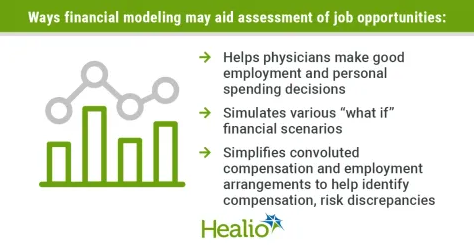
Although various factors — such as family circumstances, location, and practice conditions — play a role in a young physician’s decision to change jobs, dissatisfaction with one’s financial situation has been shown to be one of the biggest contributors to job changes.
In this column, we review a method we initially wrote about in 2019 to demonstrate how physicians can financially model their net worth in various job opportunities to help them make good employment and personal spending decisions. At its core, the technique employs a simple sensitivity analysis, similar to those used by professional analysts on Wall Street, to simulate various “what if” financial scenarios, including practice productivity.
Why Financial Modeling?
The purpose of financial modeling is to simplify convoluted compensation arrangements frequently seen in private practice employment arrangements to identify large discrepancies in compensation and risk to the young physician early in the job search process.
Fresh out of training and loaded with debt, young physicians often gravitate toward the highest-paying career opportunity, only to change practices a few years later when financial stressors decrease or practice conditions and family situations change. It is important to remember that a job’s financial benefits are only one determinant of satisfaction. Always keep your personal ‘big picture’ in mind during your career search process.
Understand the Financial Side
Although the financial aspects of a particular job are not the only criteria to consider, compensation is often cited as one of the top two reasons why physicians change employers. Many times, a young physician leaves a practice because their income expectations were vastly different than what they were actually paid.
This situation is usually made worse by the incredibly complex compensation formulas, overhead costs, and/or partnership costs that exist in various practice environments today, which often mislead a physician’s compensation expectations.
What is Financial Modeling?
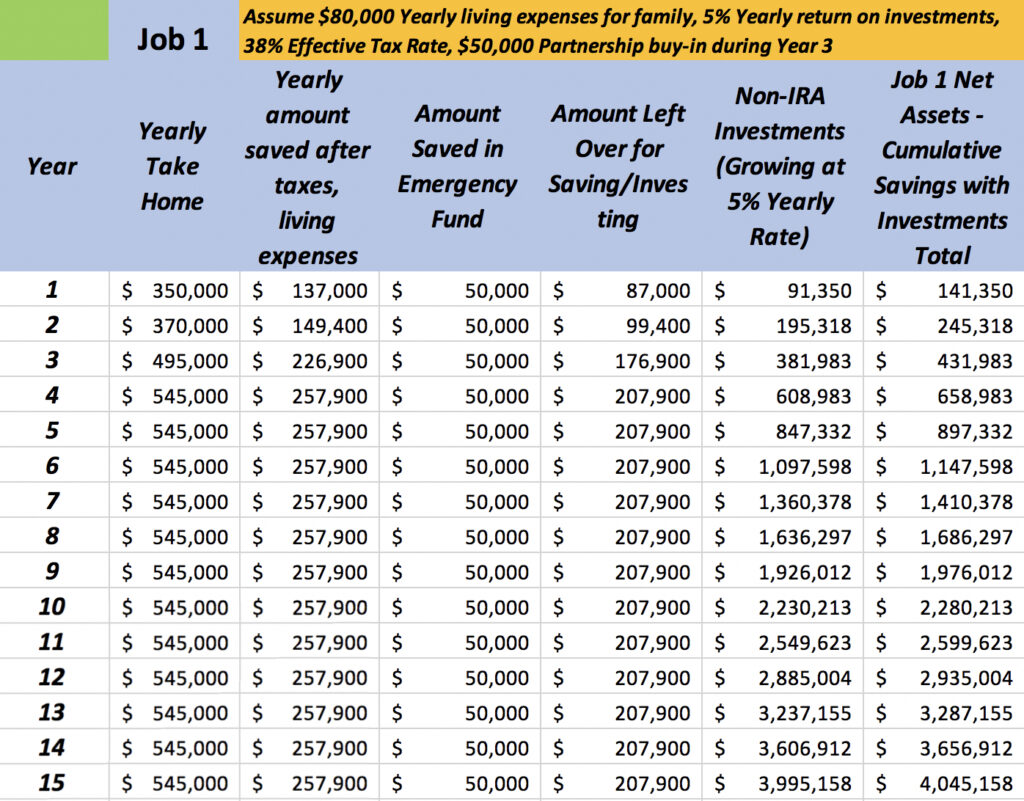
“Figure 1. Hypothetical job offer (Job 1) for a $350,000 starting salary and a $50,000 partnership buy-in cost during year 3, with production-based income thereafter. – (Source: The OJM Group)”
Financial modeling, in the finance world, is the process of creating a summary of a company’s expenses and earnings in the form of a spreadsheet that can be used to calculate the impact of a future event or decision. Company executives frequently use these tools to guide decisions and estimate stock prices, relying on the present value of future cash flows (covered in our 2019 article that discussed the importance of insuring to protect a surgeon’s future income from the effects of disability or death).
Despite its seemingly complex uses, the financial modeling process is relatively straightforward and may be of value to young physicians — executives of their own career choices — in their job decision-making processes.
Financially Modeling Future Income
If you know roughly what you might expect to make in each job opportunity, as well as various other costs, such as living expenses for your family; partnership buy-ins; and taxes, a simple spreadsheet program may be valuable in modeling your net worth based on various job opportunities.
In some situations, this practice may provide a rough estimate of what other partners are taking home as a guide for compensation, which is essential information to evaluate. Also, if you plan to invest your disposable income, it is helpful to estimate living expenses and desired rate of return to see what you may actually be able to save and compound over time.
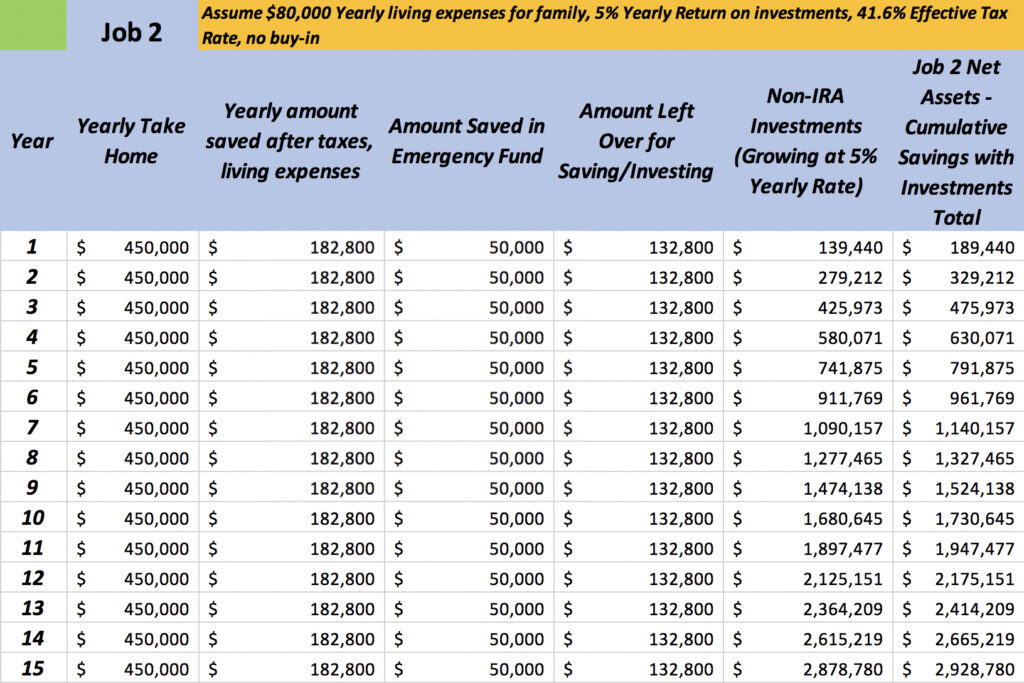
“Figure 2. Hypothetical job offer (Job 2) is shown offering a $450,000 annual salary in a state with higher taxes. (Source: The OJM Group)”
To demonstrate the value of the technique, Figure 1 is a spreadsheet designed in Microsoft Excel that depicts a hypothetical private-practice employment opportunity that offers a $350,000 starting salary and a $50,000 partnership buy-in cost during year 3. Like many private-practice opportunities, income in partnership is dependent on production. However, the practice in this example provided an estimate (Figure 1).
Figure 2 shows a spreadsheet reflecting a second job opportunity with a $450,000 annual salary in a state with higher taxes (Figure 2).
Further Analysis
If you wish to take the analysis a step further, you can graphically depict your net worth in various job opportunities side-by-side (Figure 3). Although it sounds like an overly analytical exercise for someone who probably has limited spare time, such efforts may help you better understand the trajectory of your earning potential in various job settings.
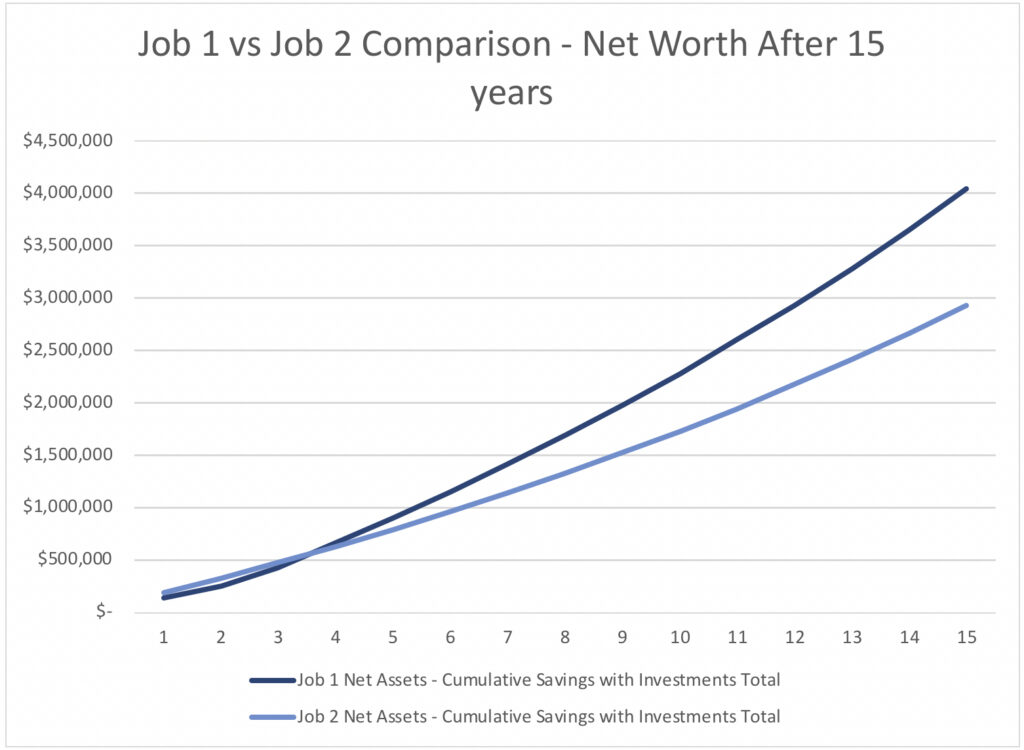
“Figure 3. Graphical side-by-side comparison of the net worth attained in Job 1 and Job 2 opportunities over a 15-year period given the listed income estimations. Note the “break-even” point occurs between years 3 and 4 with Job 1, offering the higher trajectory for growth thereafter. (Source: The OJM Group)”
In the example provided, one can see that although second; had a $100,000 higher starting salary, after 3 to 4 years the Job 2 opportunity breaks even financially with Job 1, offering a far higher trajectory for long-term earnings growth.
The value of this exercise is that it allows young surgeons to easily model a “worst case” and a “best case” scenario for each employment offer to better understand the financial risk and reward in relation to other factors more pertinent to the practice of medicine.
In Summary
Searching for a job as a young physician is among the most stressful — and exciting — times in one’s career. The decision about job selection is made more difficult by inflation and its drain on profitability. Although the financial aspects of a job should never be the only factor in choosing a certain position, many young physicians do not fully understand their compensation expectations prior to signing a job contract, which may lead to discontent later on.
Financial modeling is a simple tool that may help young physicians visualize complex compensation, arrangements typically seen in employment contracts, identify large discrepancies in compensation, and gauge physician risk for various employment offers early in the job search process.
For More Information:
Sanjeev Bhatia, MD, is an orthopedic sports medicine surgeon practicing at Northwestern Medicine in Warrenville, Illinois. He can be reached at sanjeevbhatia1@gmail.com or @DrBhatiaOrtho.
David B. Mandell, JD, MBA, is an attorney and founder of the wealth management firm The OJM Group. You should seek professional tax and legal advice before implementing any strategy discussed herein. He can be reached at mandell@ojmgroup.com or 877-656-4362.
Socially Speaking
From LinkedIn
From Twitter
How ‘Bout This?
How Locum Tenens Works & Why to Try It
(Edited from locumstory.com blog post by Jen Hunter, 9/7//2022)
In this PracticeMatch webinar, experienced locum tenens physician Ripal H. Patel, MD, MPH, dives deeply into locum tenens, how it works for him, and why physicians should try it. Click the “locum tenens” link above to get answers (from doctors who work on a locums basis) to what the industry’s largest agency (CompHealth) finds are the top 6 most-asked questions by physicians and other advanced practitioners about this contract method of practicing medicine:
- What exactly is locum tenens?
- Will locum tenens work for me?
- What’s involved in being a locum tenens?
- I’m interested, so where do I start?
- What about locum tenens for NPs & PAs?
- How do I start doing locums?
View the webinar at your convenience here.



